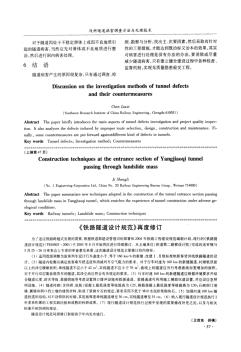铁路隧道设计规范
《铁路隧道设计规范》是2017年1月25日实施的行业标准。
近日,国家铁路局发布《铁路隧道设计规范》(TB 10003-2016)行业标准,自2017年1月25日起实施。
本规范是对2005版《铁路隧道设计规范》的全面修订,充分总结近年来我国铁路隧道建设、运营的实践经验和科研成果,贯彻落实安全优先的原则,强化了质量安全、节约资源、保护环境以及风险防范、防灾减灾等技术要求,注重总体设计,结合我国国情、经济社会发展水平、环境条件等因素,合理确定了不同运输性质类型、不同速度等级铁路隧道的主要设计标准,进一步提升了设计规范的科学性和技术经济合理性。新设计规范强调以人为本、服务运输、技术先进、经济耐久、便于养护维修的设计理念,适用于新建标准轨距铁路隧道设计。 2100433B
铁路隧道设计规范造价信息
铁路隧道设计规范常见问题
-
端墙是支挡隧道洞口仰坡的洞门墙,翼墙主要是支挡隧道洞口边坡的挡墙。
-
铁路隧道是修建在地下或水下并铺设铁路供机车车辆通行的建筑物。根据其所在位置可分为三大类:为缩短距离和避免大坡道而从山岭或丘陵下穿越的称为山岭隧道;为穿越河流或海峡而从河下或海底通过的称为水下隧道;为适...
-
JTG D70-2004 公路隧道设计规范,依然有效,没有废止,2014版是第二册。
铁路隧道设计规范文献

 《铁路隧道设计规范》再度修订 (2)
《铁路隧道设计规范》再度修订 (2)
《铁路隧道设计规范》再度修订 刊名: 现代隧道技术 英文刊名: MODERN TUNNELLING TECHNOLOGY 年,卷(期): 2004,41(2) 本文链接: http://d.g.wanfangdata.com.cn/Periodical_xdsdjs200402015.aspx

 《铁路隧道设计规范》再度修订
《铁路隧道设计规范》再度修订
《铁路隧道设计规范》再度修订 刊名: 现代隧道技术 英文刊名: MODERN TUNNELLING TECHNOLOGY 年,卷(期): 2004,41(2) 本文链接: http://d.g.wanfangdata.com.cn/Periodical_xdsdjs200402015.aspx
《铁路隧道设计规范(TB10003-2016 英文版)》由16章组成,包括总则、术语和符号、总体设计、隧道勘察、设计荷载、建筑材料、隧道洞口、隧道衬砌、洞内附属构筑物及轨道、防水与排水、通风与照明、特殊岩土和不良地质、辅助坑道、施工方法及主要措施、隧道改建、环境保护,另有10个附录。
1 General Provisions
2 Terms and Symbols
2.1 Terms
2.2 Symbols
3 Overall Design
3.1 General Requirements
3.2 Selection of Tunnel Location
3.3 Plane and Longitudinal Profile of Tunnel Route
3.4 Inner Contour
3.5 Risk Assessment and Control
3.6 Works for Disaster Prevention, Evacuation and Rescue
3.7 Interface Design
4 Tunnel Prospecting
4.1 General Requirements
4.2 Investigation, Mapping, Exploration and Testing
4.3 Classification of Surrounding Rock
5 Design Load
5.1 General Requirements
5.2 Permanent Load
5.3 Variable Load
5.4 Accidental Load
6 Construction Materials
6.1 General Requirements
6.2 Concrete
6.3 Shotcrete
6.4 Steel
6.5 Stone and Masonry
6.6 Other Common Materials
7 Tunnel Portal
7.1 General Requirements
7.2 Design of Portal Section
7.3 Protection of Dangerous Rocks and Falling Rocks around Tunnel Portal
8 Tunnel Lining
8.1 General Requirements
8.2 Composite Lining
8.3 Segment Lining
8.4 Lining of Open Cut Tunnel
8.5 Lining Calculation
8.6 Requirements on Detailed Structures
9 Auxiliary Structures and Tracks in Tunnel
9.1 Chambers
9.2 Ditches and Troughs
9.3 Tracks
10 Waterproofing and Drainage
10.1 General Requirements
10.2 Waterproofing
10.3 Drainage
10.4 Waterproofing and Drainage of Portal and Open Cut Tunnel
11 Ventilation and Lighting
11.1 General Requirements
11.2 Ventilation during Construction
11.3 Ventilation during Operation and Ventilation for Disaster Prevention
11.4 Lighting
12 Tunnels in Special Rocks and Soils and Unfavorable Geological Conditions
12.1 Tunnels in Karst Region
12.2 Tunnels in Swelling Rock (Soil)
12.3 Tunnels in Gas-containing Ground
12.4 Tunnels in Goal Area
12.5 Tunnels in High Ground Stress Area
12.6 Tunnels in Radioactive Surrounding Rock
12.7 Tunnels in Loess
12.8 Tunnels in Aeolian Sand or Water-bearing Sand Strata
12.9 Tunnels in Very Cold and Cold Area
13 Construction Adits
13.1 General Requirements
13.2 Excavation, Supporting and Lining
13.3 Lateral Adit and Parallel Heading
13.4 Inclined Shaft and Vertical Shaft
14 Construction Method and Main Measures
14.1 General Requirements
14.2 Mining Method
14.3 TBM Method
14.4 Shield Method
14.5 Open-cut Method
14.6 Geological Prediction
14.7 Monitoring
14.8 Advance Supporting and Surrounding Rock Consolidation Measures
15 Tunnel Renovation
15.1 General Requirements
15.2 Requirements on Renovation
15.3 Electrification
16 Environment Protection
16.1 General Requirements
16.2 Water Resource Protection
16.3 Protection of Natural Environment and Nearby Buildings (Structures)
16.4 Disposal of Mucks Produced in Tunnel Construction
Appendix AConstruction Gauge of Railway Tunnel
Appendix BClassification of Surrounding Rock of Railway Tunnel
B.1 Basic Classification of Surrounding Rock
B.2 Modification of Classification of Surrounding Rock of Tunnel
Appendix CSub-classification of Surrounding Rock of Railway Tunnel
C.1 Sub-classification of Surrounding Rock
C.2 Modification of Sub-classification of Surrounding Rock
C.3 Physical and Mechanical Parameters of Surrounding Rock of Each Sub-grade
Appendix DCalculation Methods for Loads of Deep Tunnel
Appendix ECalculation Methods for Loads of Shallow Tunnel
Appendix FCalculation Methods for Loads of Asymmetrically-loaded Tunnel
Appendix GCalculation Methods for Loads of Open Cut Tunnel
Appendix HCalculation Methods for Portal Walls
Appendix JCalculation Methods for Loads of Shield-bored Tunnel
Appendix KTable of Performance Parameters of Common Shaped Steel
Words Used for Different Degrees of Strictness2100433B
首先要对照《铁路隧道设计规范》和现场地质、地形核实偏压,如果确存在偏压,首先是设计有措施,施工按设计即可。
普通衬砌断面都具有承受一般偏压的能力,作为施工,应特别注意围岩锚杆质量及喷混凝土密实和监控量测。
- 相关百科
- 相关知识
- 相关专栏
- 铁路隧道设计规范(TB10003-2016 英文版)
- 铁路隧道词汇
- 铁路隧道钢筋混凝土管片
- 铁路隧道钻爆法施工机械化配套技术
- 铁路隧道锚杆
- 铁路隧道防排水设计指南
- 铁路隧道防灾救援技术
- 铁路隧道防灾疏散救援工程设计规范
- 铁路隧道防灾疏散救援工程设计规范(TB10020-2017)(英文版)
- 铁路集装箱中心站
- 铁路集装箱运输创新实践
- 铁路集装箱运输管理办法(修订)
- 铁路零担货物运输组织规则
- 铁路项目中央预算内投资专项管理暂行办法
- 铁路项目管理
- 铁路项目评估与管理
- 中国建筑抗震设计规范的演变与展望
- 中国水泥工厂余热发电设计规范国家标准即将出台
- 宜万铁路鲁竹坝2号隧道的主要工程问题及其处理措施
- 中川铁路饱和黄土地基水泥土搅拌桩静载试验
- 在铁路复杂咽喉区顶进大孔径框架桥设计施工关键技术
- 增加托架法在铁路桥梁大宽度人行道托架加固中的应用
- 工程措施对控制大跨度海底隧道结构变形施工效果
- 关于印发铁路建设工程施工招标投标实施细则通知
- 光纤自动切换保护系统在铁路光纤线路保护中应用
- 公路隧道Ⅴ级围岩初支型钢支架受力分布及动态变化
- 关于发布铁路工程建设材料价差系数通知
- 关于转发南昌铁路局营业线施工管理考核办法通知
- 关于加强铁路建设项目竣工验收管理确保按期开通
- 关于发布铁路路基土工合成材料应用设计规范通知
- 关于调整铁路建设项目材料价差指导意见
- 公路工程施工隧道施工工艺大全小导管注浆工艺流程图